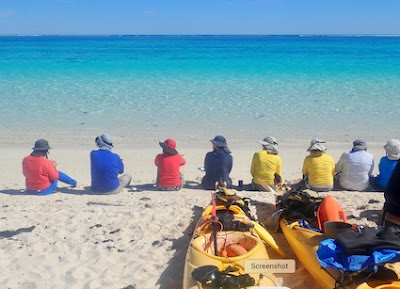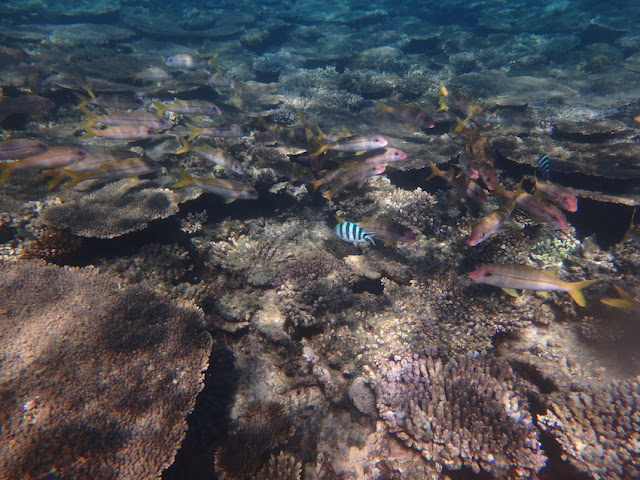Ningaloo Reef, Cape Range National Park, Coral Bay
After buying 2 new tyres in Tom Price, we had planned to go north to Millstream/Chichester National Park for a couple of days. Unfortunately, we had very heavy rain (25+ mm in one night). The vehicles coming down the road from Millstream had mud up to roofs, and we decided it was not worth the rough trip for 2 days. Instead, we stayed one night at Nanutarra Roadhouse, and then 2 days in Exmouth. On our way to Nanutarra, we went through Paraburdoo, which has this lovely sculpture that was designed and built by the community. It is called "Resilience".

The time in Exmouth was mostly doing chores, laundry, fixing broken things, and sorting ourselves out for our upcoming 5-day kayak trip. We did find time to visit the harbour, a couple of small galleries, and the tourist information/aquarium/museum. This was a large building with a lot of exhibits including huge aquariums with various species of reef fish, a history of settlement of the Exmouth area and exhibits on the natural and aboriginal history. Very well done and we only wished we had more time to see everything there.
We were very excited to be going back to Ningaloo reef, as it has some of the most accessible reef snorkelling anywhere in the world. The fringing reef comes very close to shore, and you can snorkel from the beach at a least a dozen sites in the park. There are many sanctuary zones and protected areas in the park so there are huge numbers of fish and marine mammals.
Saturday afternoon we met with our guides Neri and Matt from Exmouth Outdoor Adventures, and we were kitted up with everything we needed for our trip -- gloves, pfds, wetsuits or stinger suits, snorkel gear, bags to hold our gear -- we really didn’t have to provide anything.
On Sunday morning we folded up our camper and followed the Exmouth Outdoor Adventures bus and kayak trailer to Cape Range National Park and Ningaloo Reef. We had an early hiccup when the U-bolt holding the axle to the spring on the kayak trailer broke before we had even reached our starting point. The guides, however, with help from farmer Rob who was also travelling in his own camper trailer, made running repairs and we started only about an hour late.
Our fellow kayakers were mainly women (13 of the 15 of us) and all very interesting and friendly. A number were from the Swan Canoe Club in Perth and so we had some good paddlers.
We started just south of Tantabiddi boat ramp at Mangrove Bay, unloaded the kayaks and after a lot of packing and preparation got underway. Bill and I had a double and we took turns in the rear. Both of us had trouble with the rudder, something you don’t need in the whitewater kayaks we are more familiar with .
The day was hot and sunny and the paddles relatively short (total about 4 kilometres) and easy. We stopped for lunch on the beach, and were served wraps, cold cuts, salads, cheese, veggie options plus tea, coffee or cordial. The lunches they made out of what was carried in the kayaks were truly amazing. We saw lots of wildlife -- rays and small sharks, turtles, dolphins, osprey and a couple of dugongs close to shore while we were having lunch. Finished at Ned’s camp.
At the end of the day we beached the kayaks and chained and locked them together. We were then picked up and transported back to Exmouth Outdoor Adventures private camp just north of Yardie Creek, which is primitive but comfortable. Accommodation is tents, the toilets are long drops, and the special luxury is outdoor showers from solar heated shower bags.
Every night the guides cooked a huge dinner, starting with an appetizer of cheese, olives, and snacks. One night the main was Mexican burrito bowls, one night fish parcels, one night a yummy curry. Always finished with espresso coffee and sweets. The food was abundant and excellent.
Every morning there was a large breakfast with fruit, cereal, toast, oatmeal, coffee and tea. One morning we had a huge cooked breakfast of scrambled eggs, beans, bacon, and toast.
Our days followed a similar pattern, of paddling, snorkelling from the beach or rafted up kayaks, lunch on another beach, more paddling and/or snorkelling, and dinner back at camp. You could paddle in a double or single kayak and we tried both. The weather was beautiful and sunny with light winds (mostly behind us) and calm seas. The water was turquoise blue over fine white sand, with coral patches and bommies at the various beaches. There was always wildlife to see -- fish, sharks, rays, turtles, ospreys and eagles, dolphins, dugongs and various birds. The only wildlife we didn’t like were the March flies that were numerous and left very itchy bites.
(Sorry if you are not a fan of coral and sea creatures, but I just love them).
The activities also included some optional hikes -- one to Yardie Creek to watch the sunset from the top of the gorge, and one to Pilgramunna Gorge to see the Black Flanked Rock Wallabies.
Our days passed all too quickly and our trip came to an end. We travelled over 30 kilometres from Mangrove Bay in the north to Osprey Bay in the south. Nothing was too much trouble for our guides who worked from 5:30 in the morning making breakfast til probably 9:00 at night cleaning up after dinner. In between they herded all of the kayakers, helped the laggards, lead snorkelling expeditions, fixed broken things, and fed us morning tea and lunch. It is a good thing we were paddling as with all that food we needed to work it off.
After our last day paddling Bill and I moved to Osprey Bay Campground in the National Park. We reserved a site here for a week and continued our exploration of the reef with daily swims and snorkels. We did a short hike to some caves near Bloodwood Creek and enjoyed the incredible sunrises over the hills and sunsets over the ocean.
We also booked a “Swim with the Whale Sharks” Cruise with Ocean Eco Adventures. We had 20 people on Latitude 22, a large, converted cray boat crewed all by women, except for one of the in-water guides. The skipper, the other in-water guide, the marine biologist and photographer were all female. When we asked why they said most of the men left for better paid jobs in the resource industry.
Whale sharks are the largest fish in the sea. They have beautiful spotted skin and are not usually aggressive. Although they are big, they are filter feeders that eat zooplankton and small fish. Juvenile whale sharks, (75% male), congregate off Ningaloo from May to August.
We started our cruise with a short snorkel at Mangrove Bommie, an offshore location with clear water and great fish and coral. This was only to make sure we could all swim sufficiently to keep up with the whale sharks.
Shortly after our snorkel, word came that their aerial shark spotter had found a whale shark, and within 20 minutes we were in the water. It was truly amazing to watch these huge, docile animals cruising along through the ocean, with schools of smaller fish huddled underneath them for safety. Our whale shark was very co-operative, and we were in the water about 4 times with him as he swam. We spent a whole hour with him, which is the maximum the tour operators are allowed to stay with one shark. We also saw one other whale shark that was not so happy to see us and dived away. Later we had another swim with a larger whale shark. Apparently, we were very lucky to see 3 sharks as the average is 1.8. (What .8 of a whale shark looks like I have no idea. No tail?)
After lunch and another coral snorkel, we headed back to shore. A remarkable day and an excellent tour.
We left Cape Range National Park and spent the 22nd - 24th of May at Bullara Station, a working cattle station and caravan park halfway between Exmouth and Coral Bay. We could not get into any camping spot in Coral Bay, and we wanted to do a Manta Ray Cruise there. So we stayed at Bullara and drove into Coral Bay on Sunday to look for Manta Rays with Coral Bay Eco Tours. This turned out to be a good thing as Bullara was much more spacious and interesting than the overcrowded caravan parks in Coral Bay.
The tour was similar to the whale shark tour, with some snorkelling and luckily, swimming with Manta Rays. The boats smaller and older, but we had a very good day. We did short snorkels at two different reefs, and then the spotter plane found some Manta Rays and we were off. According to our guides, once again we were very lucky. We saw four slow swimming Manta Rays who did not seem to be upset by our presence. The rays were all circling and returning to one spot, apparently a “cleaning station” where little fish nibble the parasites off the rays.
I have only a couple of photos from the tour website as my underwater camera died while we were in Cape Range, and unlike the whale shark tour they took lots of photos, but you had to pay a lot extra for them, so we settled for the memories.
We are heading south tomorrow and meeting up with some former work colleagues of Bill’s in Perth on Sunday.










































